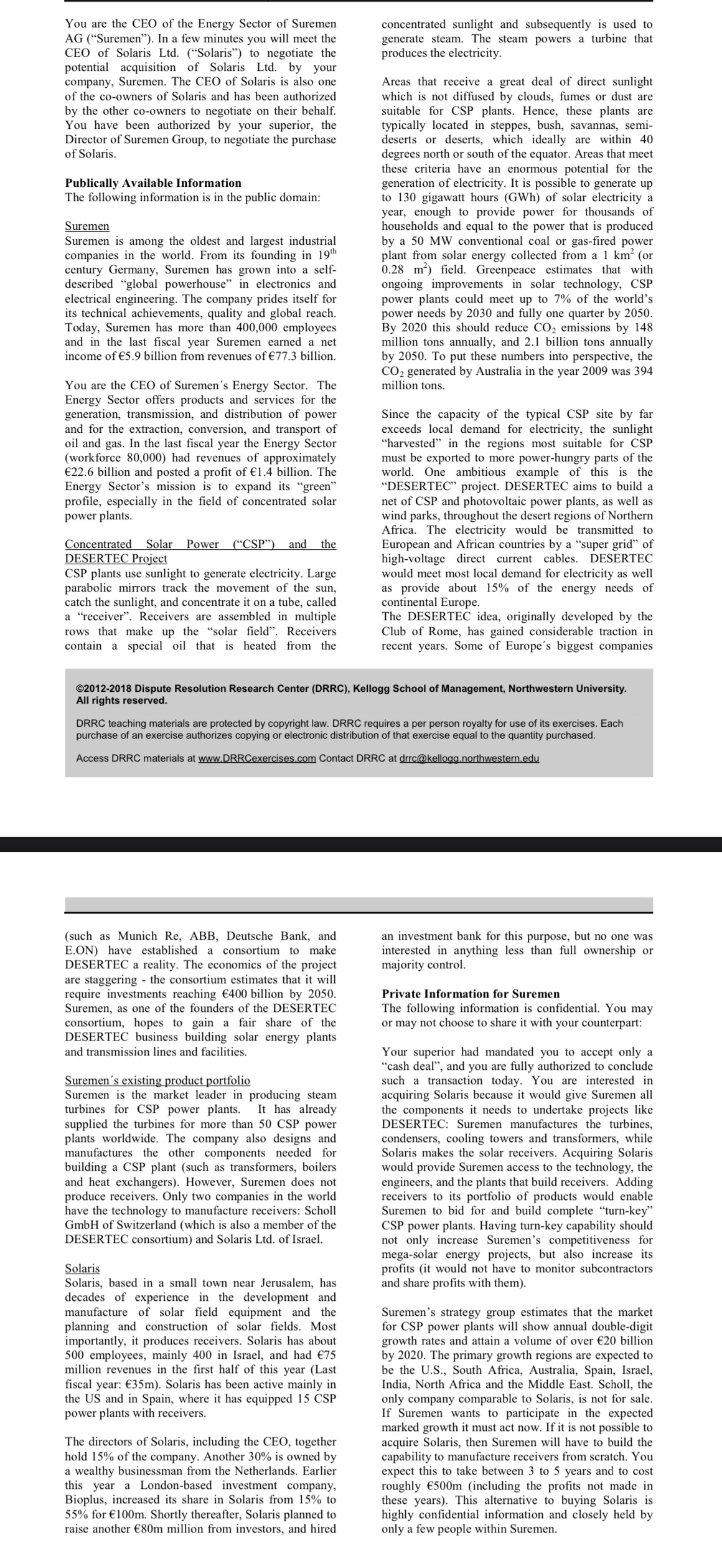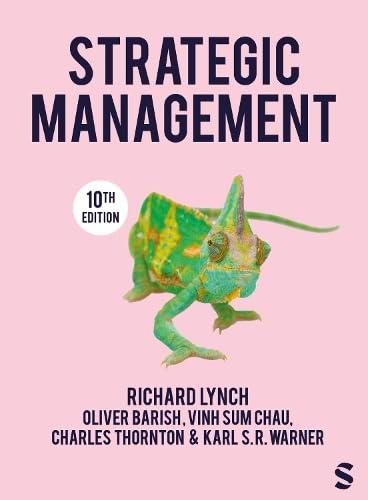This week we discussed the importance of finding and eventually agreeing upon objective criteria with your negotiation partner. The Solaris negotiation exercise gave you some factual information from which you could draw in order to determine your BATNA, reservation price, and in order to make a compelling argument about the appopriate sale price for Solaris. How did you use this information to inform your BATNA and reservation price? How did you use it to develop an argument as to the value of Solaris? In engaging in this exercise, did you find any limits to the practice of finding and agreeing upon objective criteria? Did you and your negotiation partner discuss underlying interests, or did you find it difficult to approach that conversation in what likely felt like a single-issue negotiation? Were you able to develop any creative agreements alongside your partner? Here is the picture of the document.And this is the agreement we agreeded toWas an agreement reached?Yes, Solaris will accept a cash offer of $350 millions for the sale of Solaris.If so, what are the terms of the agreement?Solaris will accept a cash offer of $350 millions for the sale of the sole rights to the company. The company will remain in Israel per Sureman's agreement, and the employees will transfer with the sale. The owners will no longer have rights or involvement in the company after the sale of the company. And all R&D products in development will stay with the previous owners of Solaris. All developed intellectual property of Solaris transfers with the sale. Were there any barriers that occurred?We did not encounter any barriers to the negotiation and the sale/purchase of the company
You are the CEO of the Energy Sector of Suremen concentrated sunlight and subsequently is used to AG ("Suremen"). In a few minutes you will meet the generate steam. The steam powers a turbine that CEO of Solaris Lid. ("Solaris") to negotiate the produces the electricity. potential acquisition of Solaris Lid. by your company, Suremen. The CEO of Solaris is also one Areas that receive a great deal of direct sunlight of the co-owners of Solaris and has been authorized which is not diffused by clouds, fumes or dust are by the other co-owners to negotiate on their behalf. suitable for CSP plants. Hence, these plants are You have been authorized by your superior, the typically located in steppes, bush, savannas, semi- Director of Suremen Group, to negotiate the purchase deserts or deserts, which ideally are within 40 of Solaris. degrees north or south of the equator. Areas that meet these criteria have an enormous potential for the Publically Available Information generation of electricity. It is possible to generate up The following information is in the public domain: to 130 gigawatt hours (GWh) of solar electricity a year, enough to provide power for thousands of Suremen households and equal to the power that is produced Suremen is among the oldest and largest industrial by a 50 MW conventional coal or gas-fired power companies in the world. From its founding in 19" plant from solar energy collected from a 1 km (or century Germany, Suremen has grown into a self- 0.28 m ) field. Greenpeace estimates that with described "global powerhouse" in electronics and ongoing improvements in solar technology, CSP electrical engineering. The company prides itself for power plants could meet up to 7% of the world's its technical achievements, quality and global reach. power needs by 2030 and fully one quarter by 2050. Today, Suremen has more than 400,000 employees By 2020 this should reduce CO2 emissions by 148 and in the last fiscal year Suremen earned a net million tons annually, and 2.1 billion tons annually income of E5.9 billion from revenues of 677.3 billion. by 2050. To put these numbers into perspective, the CO2 generated by Australia in the year 2009 was 394 You are the CEO of Suremen's Energy Sector. The million tons. Energy Sector offers products and services for the generation, transmission, and distribution of power Since the capacity of the typical CSP site by far and for the extraction, conversion, and transport of exceeds local demand for electricity, the sunlight oil and gas. In the last fiscal year the Energy Sector "harvested" in the regions most suitable for CSP (workforce 80,000) had revenues of approximately must be exported to more power-hungry parts of the E22.6 billion and posted a profit of El.4 billion. The world. One ambitious example of this is the Energy Sector's mission is to expand its "green" "DESERTEC" project. DESERTEC aims to build a profile, especially in the field of concentrated solar net of CSP and photovoltaic power plants, as well as power plants. wind parks, throughout the desert regions of Northern Africa. The electricity would be transmitted to Concentrated Solar Power ("CSP") and the European and African countries by a "super grid" of DESERTEC Project high-voltage direct current cables. DESERTEC CSP plants use sunlight to generate electricity. Large would meet most local demand for electricity as well parabolic mirrors track the movement of the sun, as provide about 15% of the energy needs of catch the sunlight, and concentrate it on a tube, called continental Europe. a "receiver". Receivers are assembled in multiple The DESERTEC idea, originally developed by the rows that make up the "solar field". Receivers Club of Rome, has gained considerable traction in contain a special oil that is heated from the recent years. Some of Europe's biggest companies @2012-2018 Dispute Resolution Research Center (DRRC), Kellogg School of Management, Northwestern University. All rights reserved. DRRC teaching materials are protected by copyright law. DRRC requires a per person royalty for use of its exercises. Each purchase of an exercise authorizes copying or electronic distribution of that exercise equal to the quantity purchased. Access DRRC materials at www.DRRCexercises.com Contact DRRC at drrc@kellogg.northwestern.edu (such as Munich Re, ABB, Deutsche Bank, and an investment bank for this purpose, but no one was E.ON) have established a consortium to make interested in anything less than full ownership or DESERTEC a reality. The economics of the project majority control. are staggering - the consortium estimates that it will require investments reaching E400 billion by 2050. Private Information for Suremen Suremen, as one of the founders of the DESERTEC The following information is confidential. You may consortium, hopes to gain a fair share of the or may not choose to share it with your counterpart: DESERTEC business building solar energy plants and transmission lines and facilities. Your superior had mandated you to accept only a 'cash deal", and you are fully authorized to conclude Suremen's existing product portfolio such a transaction today. You are interested in Suremen is the market leader in producing steam acquiring Solaris because it would give Suremen all turbines for CSP power plants. It has already the components it needs to undertake projects like supplied the turbines for more than 50 CSP power DESERTEC: Suremen manufactures the turbines, plants worldwide. The company also designs and condensers, cooling towers and transformers, while manufactures the other components needed for Solaris makes the solar receivers. Acquiring Solaris building a CSP plant (such as transformers, boilers would provide Suremen access to the technology, the and heat exchangers). However, Suremen does not engineers, and the plants that build receivers. Adding produce receivers. Only two companies in the world receivers to its portfolio of products would enable have the technology to manufacture receivers: Scholl Suremen to bid for and build complete "turn-key" GmbH of Switzerland (which is also a member of the CSP power plants. Having turn-key capability should DESERTEC consortium) and Solaris Lid. of Israel. not only increase Suremen's competitiveness for mega-solar energy projects, but also increase its Solaris profits (it would not have to monitor subcontractors Solaris, based in a small town near Jerusalem, has and share profits with them). decades of experience in the development and manufacture of solar field equipment and the Suremen's strategy group estimates that the market planning and construction of solar fields. Most for CSP power plants will show annual double-digit importantly, it produces receivers. Solaris has about growth rates and attain a volume of over 620 billion 500 employees, mainly 400 in Israel, and had 675 by 2020. The primary growth regions are expected to million revenues in the first half of this year (Last be the U.S., South Africa, Australia, Spain, Israel, fiscal year: (35m). Solaris has been active mainly in India, North Africa and the Middle East. Scholl, the the US and in Spain, where it has equipped 15 CSP only company comparable to Solaris, is not for sale. power plants with receivers. If Suremen wants to participate in the expected marked growth it must act now. If it is not possible to The directors of Solaris, including the CEO, together acquire Solaris, then Suremen will have to build the hold 15% of the company. Another 30% is owned by capability to manufacture receivers from scratch. You a wealthy businessman from the Netherlands. Earlier expect this to take between 3 to 5 years and to cost this year a London-based investment company, roughly 6500m (including the profits not made in Bioplus, increased its share in Solaris from 15% to these years). This alternative to buying Solaris is 55% for E100m. Shortly thereafter, Solaris planned to highly confidential information and closely held by raise another 680m million from investors, and hired only a few people within Suremen







